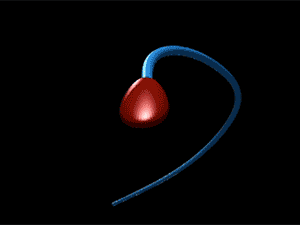Spermato-WHOA-a! Human Sperm Don’t Swim Like We Thought
For more than three centuries scientists have believed that human sperm swim by swishing their tails in a side-to-side, symmetrical motion. But that's because we've been looking at them with 2D microscopes.
Using state-of-the-art 3D microscopy, a piezoelectric device, and mathematics, researchers in Mexico discovered how sperm really move: They spin, with a wonky asymmetrical wiggle. The researchers reported their discovery today in the journal Science Advances.
It's 2020 and we all thought we knew how sperm actually swim, and we couldn't have been more wrong," says Hermes Gadelha, a senior lecturer in the Department of Engineering Mathematics at the University of Bristol. Gadelha collaborated on the project with colleagues at the Image and Computer Vision Laboratory at the National Autonomous University of Mexico.
 Gif: polymaths-lab.com
Gif: polymaths-lab.com The researchers used a high speed camera capable of recording more than 55,000 frames in one second, and a microscope staged with a piezoelectric device that moved the sperm sample up and down. The camera stayed fixed on a focal point, while the piezoelectric device oscillated in the vertical direction at a speed of 3640 m/second, which is faster than the movement of the sperm. At that speed, the sperm tail appears to not move, allowing the system to gather an image stack at each moment in 3D. The scientists then made sense of the data using mathematics.
It turns out that the sperm tail is wonky," Gadelha says. It wiggles only on one side. What prevents sperm from swimming in circles is the fact that they roll as they swim in such a way that the lop-sided stroke averages out, allowing forward movement. In other words, sperm create symmetry out of asymmetry.
This had fooled researchers previously because computer-assisted semen analysis systems (yes, that's a thing) use 2D views to look at sperm movement. From that perspective, the sperm tails, or flagellum, look like they're just swishing back and forth like eels in water.
It was known that the head spun-that was visible-but it was believed that this was connected with the rolling motion of the flagellum in a symmetrical helical wave. But as it turns out, the head is rotating and the flagellum is rotating, and these two rotations are independently coordinated," Gadelha says.
3D microscopy has been around for over a decade, but it took this long to perfect it and to bring in the other pieces-the math and the piezoelectric device-in a cohesive way. Sperm move really fast, and the problem has always been how to reconstruct something in 3D that is moving at a super fast rate and that is so small," says Gadelha.
The new knowledge of sperm motility will certainly impact fertility studies and other biological research. It could also inspire engineering projects. What the sperm is doing, after all, are computations with its body, without having a brain," says Gadelha. And isn't that an engineer's dream? Think soft robotics and artificial intelligence.
Of course, as our instrumentation improves, we might find out, once again, that our latest understanding of sperm movement is actually wrong. And that's how science goes. We are less wrong than were before," says Gadelha. But we're more wrong now than we will be in the future."